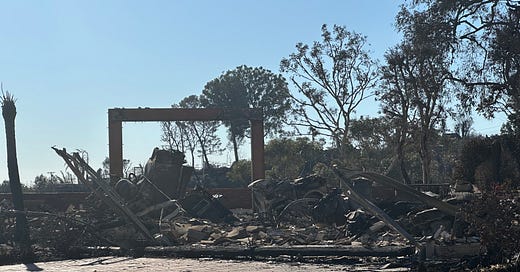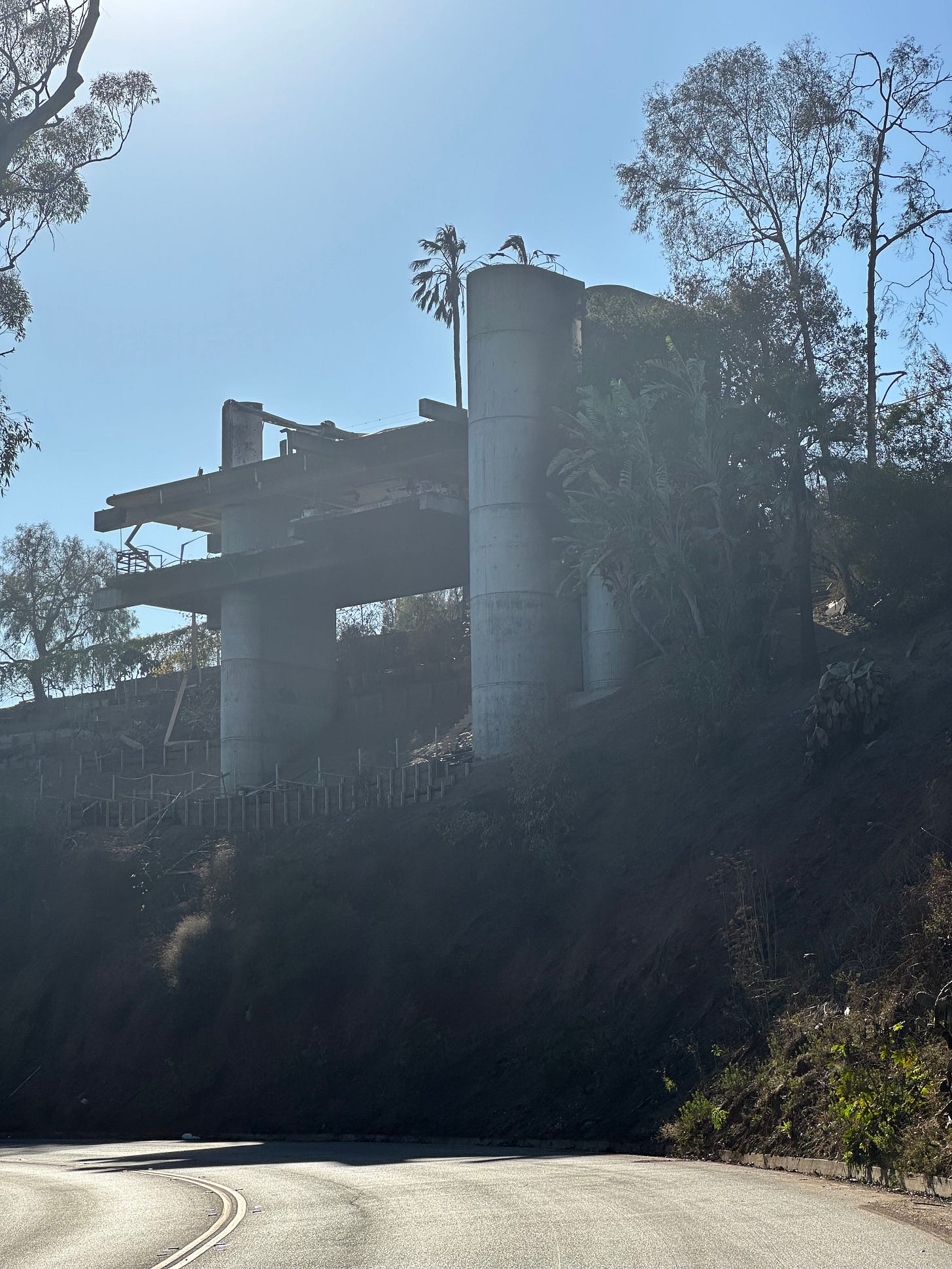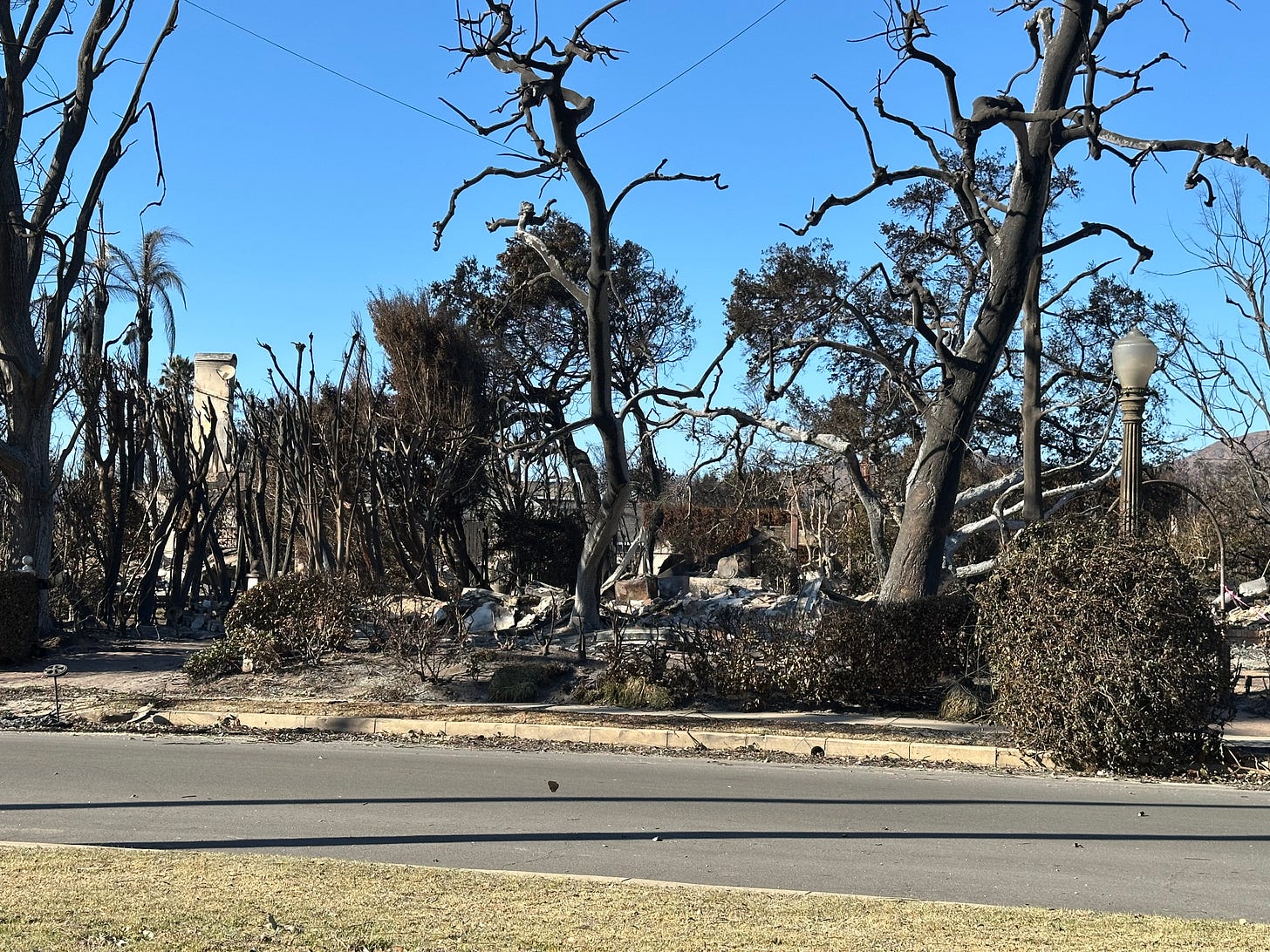Devastation LA: An update
All that remains of a home in the Pacific Palisades. Photo by Tom Teicholz
Today, the tenth day since the Palisades fire began, most of Santa Monica, including where we live, is no longer under an evacuation order or curfew. My family and I are fortunate that we remained in our home the whole time, packed and ready to go, but never being ordered to leave. There has been a lot of ash and particulate matter in the air. We keep the A/C on, and we wear masks if we are going outside. So, for us, the experience is reminiscent of the pandemic, but the visual impact of the devastation is much more visceral.
In my mind’s eye I can still see those neighborhoods, those roads, those restaurants and stores that we went to, that we enjoyed, as well as my friends’ homes where we had dinners and where we celebrated and where, nosy person that I am, I always checked out their collections – art, books, CDs, vinyl – they are now all gone, become burnt lands with twisted metal and a white brick chimney often the only indication that there once was a home, store or restaurant there.
As I write this, in the Palisades, Eaton and other related fires, over 12,000 structures were destroyed, and there are 60 square miles of burn area (larger than metropolitan Paris). Only 22% of the Palisades fire and 55% of the Eaton (Altadena) fire have been contained. As many as 150,000 Los Angelenos are still evacuated or without homes to return to. Pacific Palisades and other areas where the fire raged, such as Palisades Village and the Pacific Coast Highway, remain off limits except to firefighters, Army and National Guard, Police, and accredited media.
So, armed with a yellow LA Press Club NEWS ON ASSIGNMENT placard on my windshield, my LA Press Club identification, driver’s license, and having my online Forbes.com author’s page on my phone, I was let past the several checkpoints between Santa Monica and the Palisades.
At first, the feeling was surreal. Soldiers and Army vehicles on the streets, and blocks of homes, looking immaculate, but there were no people there. Not on the streets, not in the homes, No cars other than emergency, police, or firefighting vehicles. Occasionally, I would see another civilian car, but it was a novelty. None of the traffic lights were working, so we all proceeded with caution.
A very expensive home that was once cantilevered above Sunset Ave. Photo by Tom Teicholz
Past Amalfi Drive, as I approached the turnoff for Will Rogers State Park, I started to see on the North side, the hills turned black, trees felled and turned to charcoal, and debris spilled onto the road. I took a turn at the entrance to Will Rogers Park and followed the road up the hill. At an early turn in the road, I was surprised to see a home that had been under construction, new, untouched. But then I drove higher. The houses were now reduced to the building pad. Sometimes, the front stairs would still be there but no home. Sometimes no home, just a chimney. When I drove by a friends’ house I could no longer tell exactly where the house and its entrance had been, where the rooms were. You would drive down a street and there would be no homes left. On another maybe one. No reason or logic to it. In most of the ruins, you could see straight through where the homes were to the hills beyond. It was like a post-apocalyptic movie.
From my car window driving through the Palisades by Tom Teicholz
I returned to Sunset Blvd and drove West. As I turned past Chautauqua Road on my left, the hulls of buildings followed on the right, one after another. I took a right on Carey Street, went up a few streets and took a left heading west. There were no more homes. Block after block, building after building, cinders and chimneys. This went on for more blocks than you can imagine. I could not believe the extent of the devastation. As a reference let me compare this to Manhattan: If you were on the Upper East Side imagine all the streets from 59th Street and York Avenue West to Fifth Avenue and North to 96th – all gone. And then imagine how shocked you would be to discover that parts of Chelsea and the Westside had also burned. And that the Bronx and Westchester were still on fire. That’s the closest I can come to explaining it.
I drove down Temescal and looked for the after-school children’s theater where my daughter had once been in plays, as well as for a tree nursery a friend had once owned. Nothing remains. I went past Palisades High School, which you would recognize from a thousand movies and TV shows, where many kids I know have gone and where my daughter played club volleyball. The front buildings, contrary to my expectation looked OK, while the sports field seemed burnt. I traveled up into the Palisades, south of Sunset and came upon a pocket of homes untouched, all intact and safe. However, as these areas have been evacuated and some are without power, they exist like a ghost town, like the buildings tourists visit in Herculaneum and Pompei.
Then just two blocks north, the houses were again incinerated. I drove to Sunset and back East again through the Village. The Caruso mall looked intact (it apparently suffered little damage due to its recent construction with fire retardant materials and Caruso having engaged a private firefighting crew). It now looked like a Potemkin Village promoting happier days.
All that remains of a friend’s former home. Photo by Tom Teicholz
There is still no confirmed answer as to how the Palisades fire began. However, there is a new theory making the rounds. There was a small fire on New Year’s Day, high up in the Palisades, near Skull Rock, which could still be seen on January 2, that was thought to have been ignited by fireworks. The person who first called in the Palisades fire now believes he saw it staring in the same location as the previous fire. It may be that embers from that first fire had not died out completely and when the high winds raged, it sparked the current conflagration. That is a current theory. Although arson is being investigated, I’m not hearing a lot of reliable sources who believe the fire was intentionally set.
The Palisades and Eaton fires have in the public conversation become politicized, with a good deal of partisan finger pointing and blame placed on elected officials, party policies and agendas. Although my own biases and general optimism color what I write, my intention is to explain. So, in that spirit, a few words about Los Angeles Mayor Karen Bass, who has been much criticized and who, if elections were held today would, in the opinion of most people I know, be voted out of office.
Karen Bass, no question, failed Los Angeles on a leadership level. She was out of the country when the fires began, avoided the press and flubbed her first press conferences. When a catastrophe of this magnitude occurs, what is needed is a level of performative support and engagement. What is needed is Winston Churchill out in the streets during the London Blitz. Even the now-disgraced Rudy Giuliani was dubbed “America’s Mayor” for his leadership on 9/11, walking in the streets during the devastation. For not doing this, Bass may well have forever lost her electorate.
What is also true is that Bass’ personality is different than either Churchill’s or Giuliani’s. Bass is a quiet, reserved, behind-the-scenes kind of politician. As a Congresswoman she was enormously effective for her constituents because of her ability to work the system. Bass has a formidable set of contacts and the ability to turn the levers of politics. So, although Bass failed in the necessary performative task of leadership during a catastrophe, most likely Bass will serve Los Angeles well in the days and months to come, as getting State and Federal funds, and passing legislation and cutting red tape so that rebuilding can occur.
Driving through the devastation in the Palisades, what struck me was not the wealth or the size of the homes – you can’t even tell anymore what was there. What struck me was all the lives, all the people who lived, went to work, played, shopped, All the working people whose lives were also part of the Palisades, the construction crews, the gardeners, the store owners, the people who worked at the grocery stores, the Starbucks, the restaurants. They too have suffered a terrible loss.
For my family, the last two weeks felt much like the Pandemic with us staying indoors and leaving only briefly to run to a pharmacy or pick up takeout. In the last few days, the sun has been shining, the sky is blue and, at least where we live, the air no longer has any fire-related smell.
However, as someone who wrote a book, 9/12, about the Ground Zero responders and the illnesses they developed, I would be remiss not to remind that in the days and months following Ground Zero, Mayor Giuliani, EPA administrator Christie Todd Whitman, and President George W. Bush, told New Yorkers that the air was safe to breathe. For tens of thousands of workers and downtown inhabitants that proved tragically untrue. Particulates and toxins vaporized at high temperatures can pass through the air without taste or smell. Even cars that have dust or ash on them that drive through new neighborhoods can spread dangerous toxins. So, be safe.
Finally, what has been truly remarkable is the outpouring of support by individuals and organizations for Los Angeles. A friend of mine remarked that this good Samaritan helping impulse would not occur in Europe. He probably is right. There are many resources for those affected by the fires, including for artists.
As one example this is from a Getty press release: “A coalition of major arts organizations and philanthropists in Los Angeles led by the J. Paul Getty Trust, including the Mohn Art Collective (Hammer Museum, LACMA, and MOCA) partnered with East West Bank, today joined with the Mellon Foundation, the Helen Frankenthaler Foundation, The Andy Warhol Foundation for the Visual Arts, Qatar Museums, Ford Foundation, and other national and international institutions to announce the creation of the LA Arts Community Fire Relief Fund, an emergency relief fund for artists and arts workers… impacted by the devastating Los Angeles fires.
Los Angeles’ fashion, film and television, and arts communities have also come together in an unprecedented manner to provide, clothes, food, temporary housing resources. Many Los Angeles museums and cultural institutions will be free this weekend. T-shirts and Art prints have been created with funds going to help the victims of the fires.
Although the magnitude of this current tragedy will reverberate for many, many years to come, let us not forget the humanitarian response that represents the best of America.






